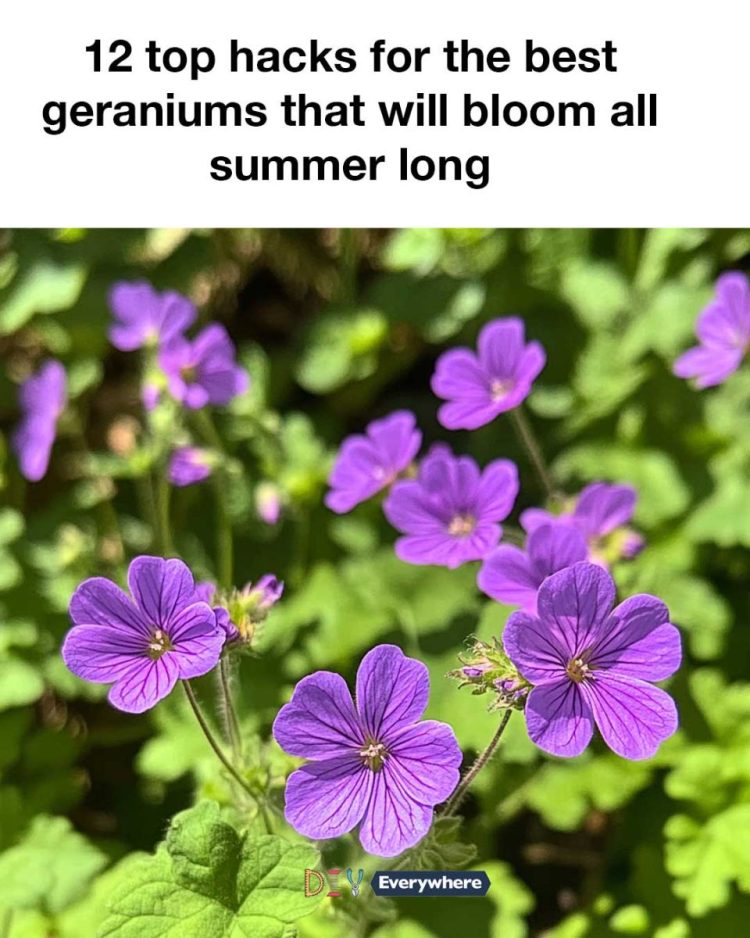After the first flush of blooms, cut back the stems by one-third to encourage a second round of flowering. Use sharp, clean scissors or pruning shears to make clean cuts just above a leaf node.
6. Fertilizing Schedule for Vibrant Flowers
Geraniums benefit from regular feeding to support their vigorous growth and flowering. Use a balanced, water-soluble fertilizer with an N-P-K ratio of 10-10-10 or 20-20-20 every 4 to 6 weeks during the growing season.
Be careful not to over-fertilize, as this can lead to lush foliage at the expense of blooms. If your geraniums are not flowering as expected, consider switching to a fertilizer higher in phosphorus, such as a 15-30-15 formula, to boost flower production.
7. Pest Control Hacks to Keep Geraniums Healthy
Common pests that affect geraniums include aphids, spider mites, and whiteflies. To keep these pests at bay, regularly inspect your plants and remove any affected leaves. A strong spray of water can dislodge small infestations.
For more persistent problems, consider using insecticidal soap or neem oil, which are effective and environmentally friendly options. Introduce beneficial insects like ladybugs and lacewings to your garden to naturally control pest populations.
8. Companion Planting to Enhance Growth
Companion planting can enhance the growth and health of your geraniums. Pair them with plants like marigolds, which repel nematodes, or basil, which can deter aphids. These companions not only help protect your geraniums but also add diversity and beauty to your garden.
Avoid planting geraniums near plants that require significantly different growing conditions, such as those that prefer shade or consistently moist soil, as this can lead to competition for resources.
9. Using Mulch to Retain Moisture and Suppress Weeds
Applying a layer of mulch around your geraniums helps retain soil moisture and suppress weed growth. Use organic mulches like shredded bark, straw, or wood chips, applying a 2 to 3-inch layer around the base of the plants.
Be sure to keep the mulch a few inches away from the stems to prevent rot. Mulching not only conserves water but also adds organic matter to the soil as it breaks down, improving soil fertility over time.
10. Deadheading for Prolonged Blooming
Deadheading, or removing spent blooms, is a simple yet effective way to encourage prolonged blooming in geraniums. Regularly check your plants and snip off any faded flowers just above the first set of healthy leaves.
This practice prevents the plant from setting seed and redirects its energy into producing more flowers. Make deadheading a part of your routine garden maintenance to keep your geraniums looking their best throughout the summer.
11. Overwintering Strategies for Year-Round Success
To enjoy your geraniums year after year, consider overwintering them indoors. Before the first frost, dig up your geraniums and pot them in containers with fresh potting soil. Trim back the foliage by one-third and place them in a sunny window.
Water sparingly during the winter months, just enough to keep the soil from drying out completely. In spring, gradually acclimate your geraniums to outdoor conditions before replanting them in the garden.
12. Viral DIY Hacks for Stunning Geranium Displays
Get creative with your geranium displays by incorporating DIY hacks that add visual interest. Use recycled materials like old tires or wooden pallets as unique planters. Paint them in bright colors to complement the vibrant hues of your geraniums.Consider creating a vertical garden by attaching small pots to a trellis or wall. This not only saves space but also creates a stunning focal point in your garden. Experiment with different arrangements and let your creativity shine.

12 top hacks for the best geraniums that will bloom all summer long
ADVERTISEMENT
For Complete Cooking STEPS Please Head On Over To Next Page Or Open button (>) and don’t forget to SHARE with your Facebook friends
ADVERTISEMENT